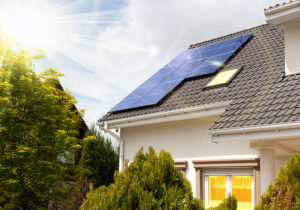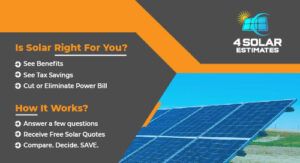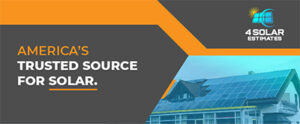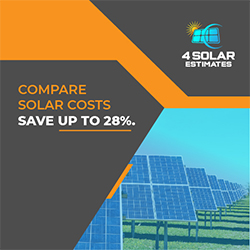
Top 10 Benefits of Solar Energy in 2023
As the world leans towards greener energy solutions, solar power continues to shine brightly as a clean, renewable, and increasingly affordable option. If you’ve considered installing solar panels or investing in solar energy, this comprehensive guide will enlighten you on the top 10 benefits of solar energy in 2023.
COMPARE SOLAR QUOTES1. Reduced Energy Bills
One of the primary advantages of solar energy is the significant reduction in electricity bills. Solar panels generate their own power, and therefore can significantly offset, if not eliminate your monthly electricity bill. The amount you save will depend on the size of your solar system and your electricity usage.
2. Excellent Return on Investment
Solar panels aren’t an expense – they’re an investment. With substantial electricity bill savings, most homeowners pay off their solar panel system in seven to eight years and see an ROI of 20 percent or more.
3. Energy Independence
Solar energy provides a level of independence by allowing you to generate your own electricity. This means you’re less dependent on your local utility company and less affected by energy price increases or grid outages.
4. Sustainable and Renewable
Solar energy is both sustainable and renewable, meaning it won’t run out, and we can keep using it without depleting the resource. This makes it an excellent solution for reducing our reliance on fossil fuels and lowering greenhouse gas emissions.
5. Grid Security
During periods of high demand, blackouts, and brownouts often occur. However, buildings equipped with solar power systems contribute to the energy solution by reducing the load on the grid. The more homes and businesses with independent solar systems, the more grid security we have.
6. Increasing Home Value
Research shows that homes with solar energy systems have higher property values and sell more quickly than non-solar homes. As homebuyers become more educated about solar, demand for properties equipped with solar panel systems will continue to rise.
7. Federal Tax Credits
The federal government provides a solar tax credit, known as the investment tax credit (ITC). The ITC allows you to deduct a significant portion of your solar energy system installation costs from your federal taxes, making solar energy even more affordable.
8. Job Creation and Economic Growth
The solar industry contributes to job creation and economic growth. According to The Solar Foundation, the solar industry adds jobs many times faster than the overall U.S. economy.
9. Versatility and Scalability
Solar power can be used for various purposes, from powering homes and businesses to heating water and producing electricity in remote locations. Additionally, solar systems can be scaled according to your needs, whether you need a small installation for a single home or a massive installation for a power plant.
10. Technological Innovation
The solar sector is constantly advancing and improvements will intensify in the future. Innovations in quantum physics and nanotechnology can potentially increase the effectiveness of solar panels and double, or even triple, the electrical output of solar power systems.

The benefits of solar energy are clear. Not only does solar power reduce your electricity bills, it also has a positive impact on the environment, contributes to energy independence, and drives economic growth. As technology continues to advance and the cost of solar panels drops, there’s never been a better time to make the switch to solar energy.
How Do Solar Panels Work?
Understanding how solar panels work can give you a greater appreciation for this impressive technology and its role in reducing our reliance on fossil fuels and lowering our carbon footprint. At a high level, solar panels work by converting sunlight into electricity that your home or business can use, reducing your energy bills. But let’s dive a bit deeper into the process.
COMPARE SOLAR QUOTESThe Science Behind Solar Power
Solar panels are made up of smaller units called photovoltaic cells (PV cells), which convert sunlight directly into electricity. PV cells are made of semiconducting materials, like silicon, that absorb sunlight.
When sunlight hits a PV cell, it excites the electrons in the semiconductor material. With the energy from this sunlight, electrons are knocked loose from their atoms. This allows them to flow freely through the material to produce a current.
This current, together with the cell’s voltage (which is a result of its built-in electric field or fields), defines the wattage that the solar cell can produce.
From Sunlight to Usable Electricity
The electricity generated by a solar panel isn’t immediately usable in your home, though. That’s because solar panels produce direct current (DC) electricity, while our homes and businesses use alternating current (AC) electricity. To make the electricity from solar panels usable, a solar power system includes an inverter, which converts the DC electricity into AC electricity.
Storing Solar Energy
For those times when the sun isn’t shining, many solar power systems also include a battery storage system. Excess electricity generated by the solar panels charges the battery so that you can use solar-generated electricity even at night or on cloudy days.
Net Metering: Selling Excess Energy Back to the Grid
In many places, you can even sell any excess electricity your solar panels generate back to the electrical grid. This is possible thanks to net metering, a utility billing mechanism that credits solar energy system owners for the electricity they add to the grid. This not only further reduces your energy bills, but it also supplies the grid with clean, renewable energy.
By understanding the science behind solar power and how solar panels work, it’s easy to see why more and more people are choosing to install a solar power system. The process of converting sunlight into electricity is a clean, renewable way to reduce our reliance on fossil fuels, lower our carbon footprint, and significantly cut our energy bills. With the advancement of solar technology, this amazing renewable energy source will continue to become more efficient and affordable for everyone.
The 3 Main Types of Solar Panels
When considering a solar power system, it’s important to understand the different types of solar panels available. Each type has its own unique characteristics and benefits. The three main types of solar panels are:
- Monocrystalline Solar Panels (Mono-SI): These are the most efficient and expensive solar panels. Made from a single crystal structure, they offer the highest performance because the composition of each cell is uniform. They can be identified by their dark black color and the rounded edges of the cells.
- Polycrystalline Solar Panels (Poly-SI): Unlike mono-SI panels, poly-SI panels are made from multiple crystal structures. This gives them a distinctive blue color and makes them less efficient. However, they are also less expensive, making them a popular choice for residential solar installations.
- Thin-Film Solar Cells (TFSC): As the name suggests, thin-film solar cells are the thinnest and least efficient of the three types. However, they’re also the cheapest and most flexible, making them suitable for certain applications where flexibility and cost are more important than efficiency. They can be identified by their homogeneous appearance as there are no individual cells visible.
Each type of solar panel has its pros and cons, and the best one for you will depend on your specific situation. Factors to consider include your budget, the amount of space you have available for solar panels, and the amount of sunlight your location receives. An experienced solar installer can help you determine which type of solar panel is best for your needs.

Solar Panels and Power Outages: How Does It Work?
When planning to switch to solar energy, one common question is: “How do solar panels work during a power outage?” It’s an important consideration, particularly for those living in areas prone to frequent power outages. The answer largely depends on your solar power system’s setup and whether you have a battery storage system in place.
Grid-Tied Solar Systems and Power Outages
The majority of solar systems are grid-tied, meaning they’re connected to the public electricity grid. During the day, these systems generate electricity that is used immediately by the home. Any excess energy generated is sent back to the grid, offsetting electricity costs and reducing your electricity bills.
However, in a power outage, most grid-tied solar systems automatically shut off. This is a safety measure known as “anti-islanding,” designed to protect utility workers who might be repairing the electrical lines. If your solar system continued to send electricity back to the grid during a power outage, it could potentially harm those workers.
Solar Systems with Battery Storage
For solar power systems equipped with a battery storage system, the situation during a power outage is different. When your solar panels generate excess energy, instead of sending that energy back to the grid, it’s stored in a battery for later use.
During a power outage, instead of shutting down completely, the system can disconnect from the grid (a process called “islanding”) and your home can run off the energy stored in the battery. The size and capacity of your battery storage system will determine how long you can power your home during an outage.
COMPARE SOLAR QUOTESConsidering a Solar + Storage System
If you live in an area where power outages are common, it might be worth considering a solar system with a battery storage option. While the upfront costs can be higher, being able to use your solar energy during a power outage can provide peace of mind and maintain essential services in your home.
While a standard, grid-tied solar system will shut down during a power outage, solar systems with a battery storage system can continue to provide power. Considering your needs and the prevalence of power outages in your area can guide you in choosing the solar power setup that’s right for you. Regardless of your choice, investing in a solar power system remains a great way to reduce your electricity bills and create a more sustainable future.
The Cost of Solar Energy: An Investment That Pays Off
As more homeowners and businesses turn to renewable energy, understanding the costs of solar energy becomes essential. While the upfront cost might seem high, it’s important to view solar panels as a long-term investment that offers substantial savings over time.
Upfront Costs of Solar Panels
The cost of a solar power system depends on several factors, including the size of the system, the type of solar panels, the configuration of your roof, and your location. As of 2023, the average cost of solar panels in the U.S. is around $2.81 to $3.22 per watt. For a typical 5 kilowatt (kW) residential solar system, this translates to an upfront cost of $14,050 to $16,100 before any federal or state incentives.
Solar Incentives and Tax Credits
To encourage the adoption of solar power, various federal, state, and local incentives can significantly lower the cost of solar panels. For instance, the federal solar tax credit, or investment tax credit (ITC), allows homeowners to deduct a portion of their solar costs from their taxes. Some states, local governments, and utilities also offer rebates and other incentives that can further reduce the cost of solar panels.
Solar Panels and Energy Bills Savings
Once installed, solar panels start saving you money by reducing your electricity bills. The amount you save will depend on several factors, including:
- Solar Energy Production: The amount of sunlight in your area and the efficiency of your solar panels will determine how much electricity your system can produce.
- Electricity Rates: The cost of electricity in your area will also impact your potential savings. The higher the local electricity rates, the more you’ll save by generating your own power.
- Energy Consumption: The amount of electricity you use will also determine your savings. The more power you consume, the greater your potential savings when you generate your own electricity.
On average, homeowners can expect to save between $10,000 to $30,000 over the life of their solar power system.

The True Value of Solar Panels
In evaluating the cost of solar panels, it’s crucial to consider their long-term value. These systems often last 25 to 30 years or more, meaning they provide decades of clean, renewable energy. And, with rising electricity rates, the savings from solar panels will only increase over time.
Moreover, installing solar panels can increase your property value. Numerous studies have found that homes with solar panels sell faster and for more money compared to homes without solar panels.
While the cost of solar panels can seem high initially, the long-term savings and benefits make it a wise investment. Lower energy bills, tax incentives, and increased property value all contribute to the economic appeal of solar energy. When you also consider the environmental benefits of reducing carbon emissions and promoting renewable energy, it’s clear that solar energy is a smart and sustainable choice.
COMPARE SOLAR QUOTESTop Solar Panel Companies in 2023
Choosing the right solar panel provider is crucial for ensuring you get the best performance and value from your solar power system. Here’s a look at some of the top solar panel companies in 2023, based on factors like efficiency, durability, warranty, and customer reviews:
1. SunPower
SunPower is known for manufacturing the highest-efficiency solar panels on the market. Their panels are durable and come with an industry-leading 25-year warranty that covers both product and performance. Their Maxeon series panels are particularly popular for residential installations.
2. LG Solar
A subdivision of the South Korean electronics giant, LG Solar produces high-quality solar panels known for their durability and efficiency. Their NeON 2 and NeON R series are very popular and come with a 25-year product warranty, which is above industry standards.
3. Panasonic
Panasonic offers high-efficiency solar panels that are well-regarded for their performance and reliability. Their panels come with a comprehensive 25-year warranty and perform well in all weather conditions, including high temperatures and low light.
4. Canadian Solar
One of the world’s largest solar energy companies, Canadian Solar offers high-quality panels at a competitive price point. Their panels are known for their durability, and they offer a range of products to suit different needs and budgets.
5. Q CELLS
Q CELLS, a German-founded company now based in South Korea, is another leading manufacturer of high-quality, high-efficiency solar panels. They are particularly noted for their excellent performance in low-light conditions.
6. Trina Solar
Trina Solar is one of the world’s leading providers of solar energy solutions and produces a wide range of solar panels suitable for both residential and commercial use. Trina Solar panels are well-known for their reliability, efficiency, and affordability.
7. JinkoSolar
JinkoSolar is currently the world’s largest solar panel manufacturer. The company offers a variety of high-quality panels that balance efficiency and cost-effectiveness. Their products are available worldwide and are suitable for a wide range of applications, from small residential installations to large utility-scale projects.
8. First Solar
First Solar is unique in this list because they primarily produce thin-film panels, which are different from the crystalline silicon panels that other manufacturers produce. Thin-film panels from First Solar are particularly suitable for large-scale installations.
When choosing a solar panel company, it’s important to consider not only the price but also the panel’s efficiency, warranty, and the company’s reputation. This ensures you get the best return on your solar energy investment.

Solar Energy vs. Traditional Electricity: A Comparison
As more homeowners and businesses are searching for ways to reduce their carbon footprint and energy costs, solar energy has emerged as a viable alternative to traditional electricity. This shift towards solar energy is increasingly being supported by various financial incentives from state governments and federal authorities to promote renewable energy sources.
Let’s explore the differences between solar energy and traditional electricity, examining factors like cost, environmental impact, and reliability.
Cost Comparison
While the upfront cost of a solar energy system may be higher than continuing to pay for traditional electricity, solar can be much cheaper over the long run. This is because once your solar panels are installed and operational, the energy they generate is free. With traditional electricity, you continually pay for energy consumption.
Moreover, many state governments offer financial incentives like tax credits and rebates that can significantly decrease the cost of installing solar panels. Over time, the savings on your energy bills can recoup the initial investment. The exact savings will depend on several factors, such as the size of your system, your location, and the amount of sunlight you receive.
Environmental Impact
When it comes to environmental impact, solar energy has a clear advantage. Solar panels produce clean, green energy from the sun, reducing reliance on fossil fuels. This helps to decrease greenhouse gas emissions and slow climate change. On the other hand, traditional electricity is often generated from burning fossil fuels, which release carbon dioxide and other harmful pollutants into the atmosphere.
Reliability and Energy Independence
One of the main benefits of a solar energy system is the ability to generate your own electricity. This energy independence means you’re less affected by energy price increases and supply disruptions. Traditional electricity relies on an aging grid that can be susceptible to outages, whereas solar energy can provide reliable power, particularly if paired with a battery storage system.
However, solar energy production does depend on weather conditions, and energy generation is minimal during the night or overcast days. Fortunately, improvements in battery technology are making it easier to store excess solar power for use when needed, increasing the reliability of solar power.
COMPARE SOLAR QUOTESWhile both solar energy and traditional electricity have their pros and cons, solar energy presents a compelling case in terms of cost savings, environmental benefits, and energy independence. The financial incentives from state governments and other entities further add to the appeal of solar energy.
The choice between solar and traditional electricity will depend on your specific circumstances, including your budget, energy needs, and environmental goals. Regardless, it’s clear that solar energy is a viable and sustainable alternative to traditional electricity and is set to play an increasingly important role in our energy future.
Federal Solar Tax Credit: How Does It Affect You?
One of the most significant financial incentives for adopting solar energy is the federal solar tax credit, also known as the Investment Tax Credit (ITC). This government initiative significantly reduces the cost of a solar panel system, making it a more affordable and viable option for homeowners and businesses.
What is the Federal Solar Tax Credit?
The ITC allows homeowners and businesses to deduct a percentage of the cost of installing a solar energy system from their federal taxes. The credit applies to both residential and commercial systems, and there is no cap on its value.
When the ITC was first introduced, it allowed for a deduction of 30% of the cost of the system. However, this rate is set to decrease over time. For systems installed after December 31, 2020, the credit was set at 26%. After 2022, it will drop to 22%, and by 2024, the residential credit will disappear completely, while the commercial and utility credit will drop to a permanent 10%.

How Does the Federal Solar Tax Credit Affect You?
Simply put, the federal solar tax credit can save you thousands of dollars on the cost of your solar panel system. For instance, if your solar energy system costs $15,000 and is installed in 2023, you could deduct 22% of that cost ($3,300) from what you owe on your federal taxes. If you don’t owe that much, the remaining credit can be rolled over to the next year.
It’s important to note that to take advantage of the ITC, you must buy your solar system outright (either with cash or a loan). If you lease your system or enter into a power purchase agreement (PPA), the credit goes to the system owner—not you.
Other Financial Incentives for Solar Panels
In addition to the federal ITC, there are numerous other financial incentives available, depending on where you live. These can include state, local, and utility tax credits, rebates, and incentives.
- For example, some states offer net metering programs, which allow you to sell any excess electricity your solar panels generate back to the grid.
- This not only reduces your electricity bill but could even turn it into a credit.
- Other incentives might include property and sales tax exemptions, Solar Renewable Energy Certificates (SRECs), and feed-in tariffs.
The federal solar tax credit and other financial incentives significantly reduce the cost of installing a solar energy system. If you’re considering going solar, it’s a good idea to act soon to take full advantage of these incentives before they decrease or disappear entirely. Always consult with a tax professional to understand how the federal solar tax credit and other incentives may apply to your specific situation.
COMPARE SOLAR QUOTES
Leave a Reply